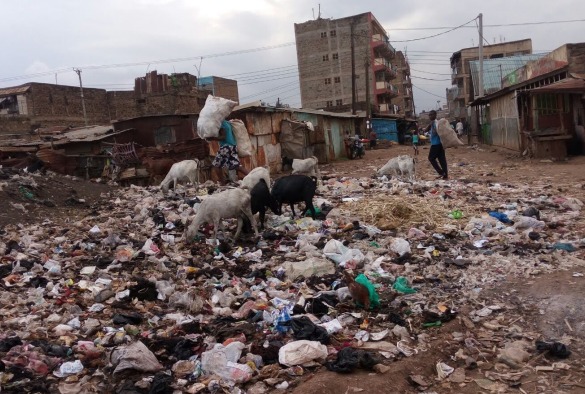
A new paper sets out key research done by scientists at the University of Liverpool with partners to show that disease may be more likely to jump from animals to humans in parts of a city hosting high densities of people, livestock and urban-adapted wildlife such as rats.
The study, done in the fast-growing capital city of Nairobi, Kenya, shows risk areas tend to be lower income with a lack of adequate sanitation and waste management as well as lower levels of biodiversity. The long-term study is among the first to unequivocally answer questions of where and how disease transmission and emergence occurs in urban settings.
Significantly the paper suggests public health recommendations, including places to prioritise disease surveillance, improve access to basic healthcare and explore targeted disease control measures.
Conducted from 2013 – 2017, it was led was Professor Eric Fèvre, Chair of Veterinary Infectious Diseases at the University of Liverpool and the then PhD student at the University of Liverpool, Dr. James Hassell in collaboration with Kenyan partners, and funded by the Medical Research Council. Dr Hassell is now a wildlife veterinarian and epidemiologist for the Smithsonian’s National Zoo and Conservation Biology Institute (NZCBI)’s Global Health Program.
The study’s findings were based on genetic relationships between E. coli bacteria collected from a group of more than 2,000 people, livestock and urban wildlife from 33 locations across Nairobi.
E. coli bacteria have some genes, called mobile genetic elements, that carry traits like drug resistance and can be transferred to other E. coli nearby. This allowed investigators to infer the same kind of close physical proximity between any E. coli that shared many of the same mobile genetic elements.
Dr. James Hassell said: “This genetic similarity is a good proxy for disease transmission potential between two hosts. We can’t know if the bacteria were transferred from human to animal or animal to human, but it tells us something important about the epidemiological connection between them.
“In these high population density areas, people and animals are really closely connected from a potential disease transmission standpoint. These are the places where the ingredients are there for emerging pathogens to jump from animals to humans, and places where it would be easy for those pathogens to multiply before being detected. This means these places are also where it makes sense to prioritise access to healthcare and disease surveillance.”
Comparing the E. coli bacteria collected from people, wildlife and livestock across Nairobi allowed the scientists to map parts of the city that featured the most overlap in these bacterial genes and, ultimately, identify these areas as key battlefronts for emerging diseases.
Though the results apply directly to Nairobi, Kenya city is emblematic of many cities in the tropics experiencing what researchers’ term rapid, unplanned urbanisation. When cities grow extremely fast without meaningful urban planning they are often missing basic infrastructure such as adequate sanitation or waste management systems, especially in low-income neighborhoods.
Combine these conditions with high population densities and large numbers of residents still relying on livestock to support their families, and opportunities for diseases to jump from animals to humans abound.
Follow-up research is currently trying to gather even more information on the mechanisms of disease transmission in Nairobi by placing tracking devices on livestock, bats and birds from many of the same households surveyed in the current study. The study will use GPS tracking as well as devices called proximity loggers that record when two animals wearing the devices get closer than half-a-foot from one another to build contact networks.
Kenyan partner organisations that contributed to this study and ongoing collaborative research include the International Livestock Research Institute, the University of Nairobi, Kenya Medical Research Institute, National Museums of Kenya and Kenya Wildlife Service.
Additional partners in this study and paper included the University of Edinburgh, University of Minnesota, University of Oxford, University of Southampton, Hokkaido University Columbia University, University of Milan and Food and Agriculture Organization of the United Nations.
The paper, ‘Epidemiological connectivity between humans and animals across an urban landscape’ is published in Proceedings of the National Academy of Sciences (https://doi.org/10.1073/pnas.2218860120)